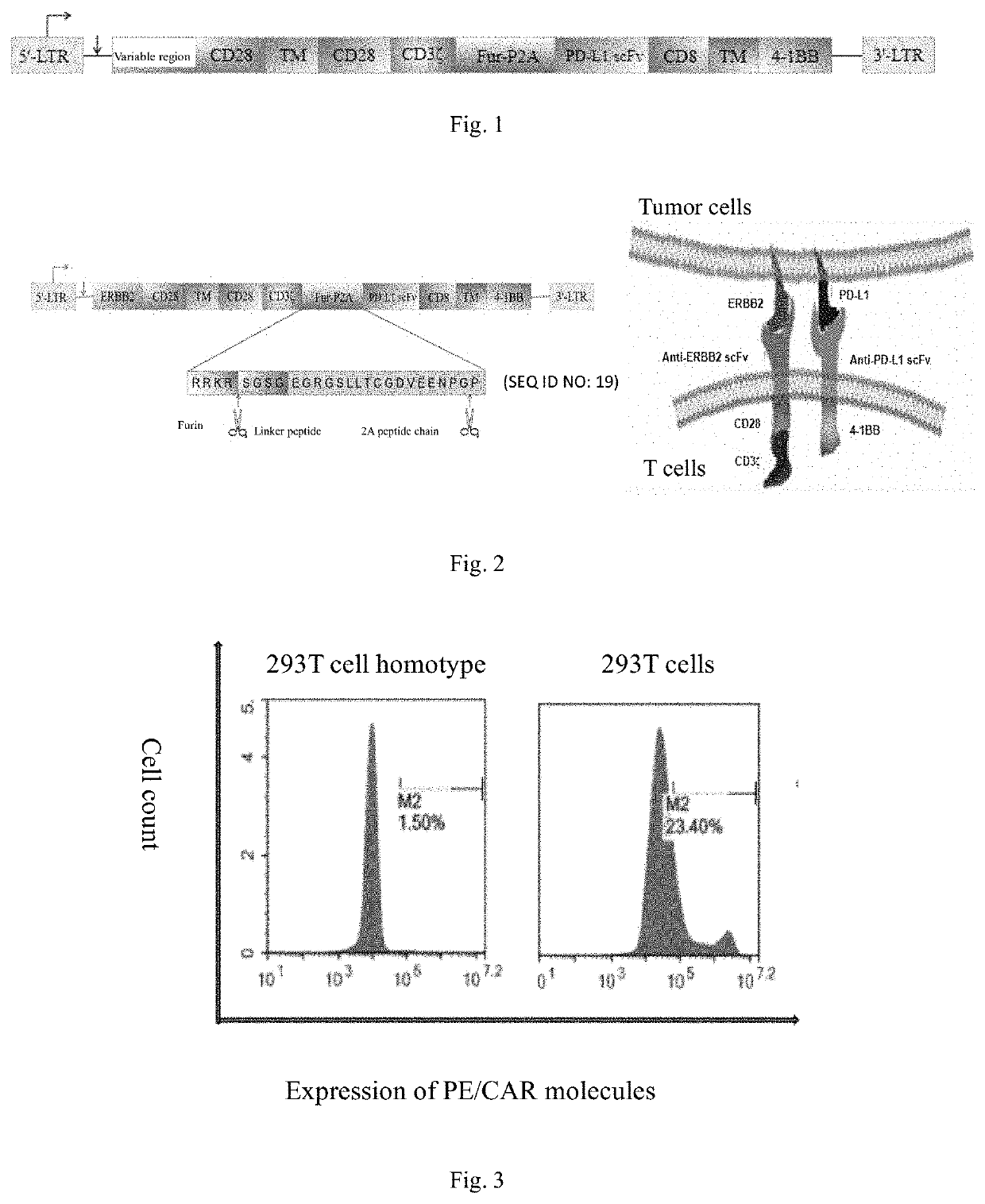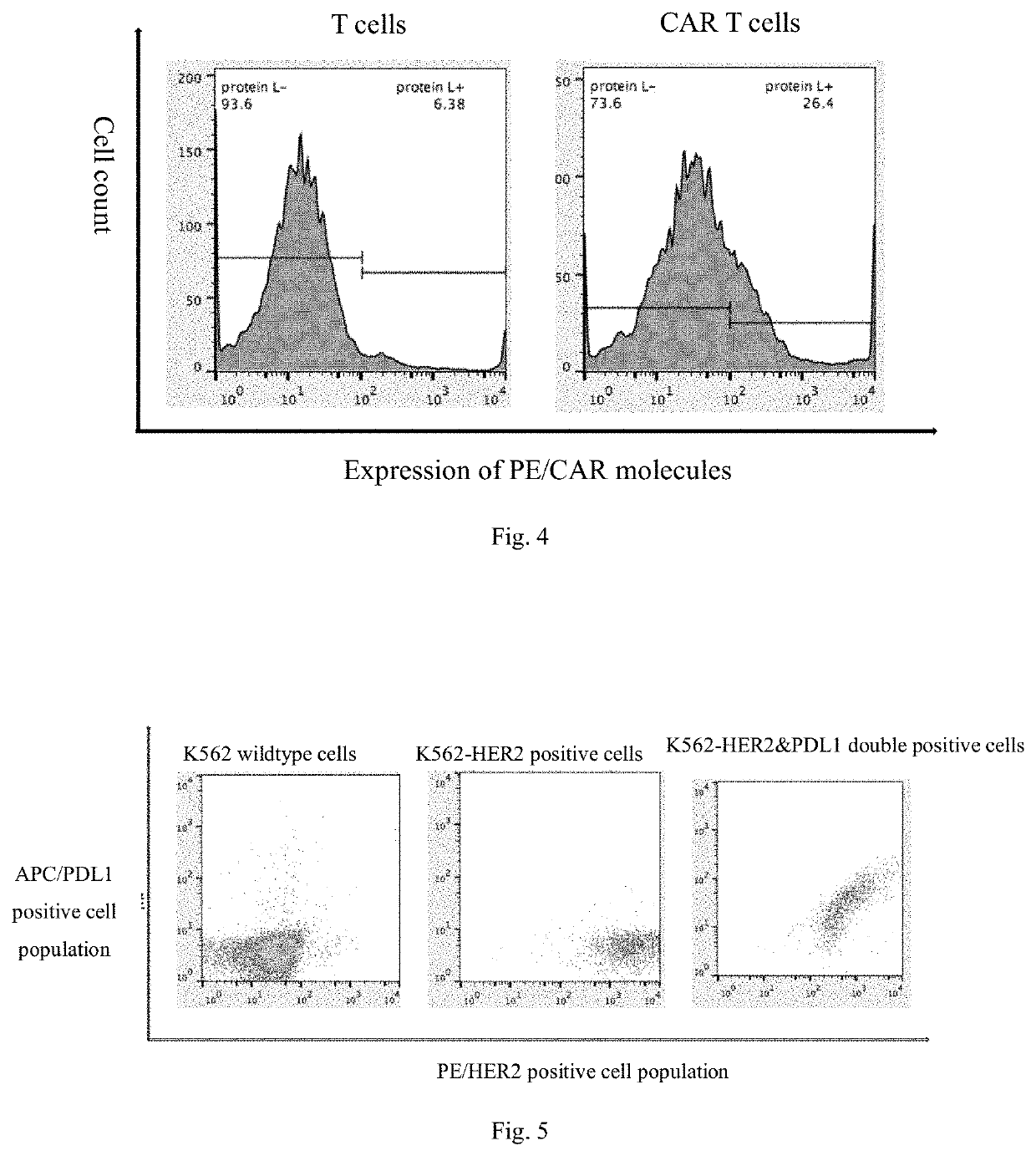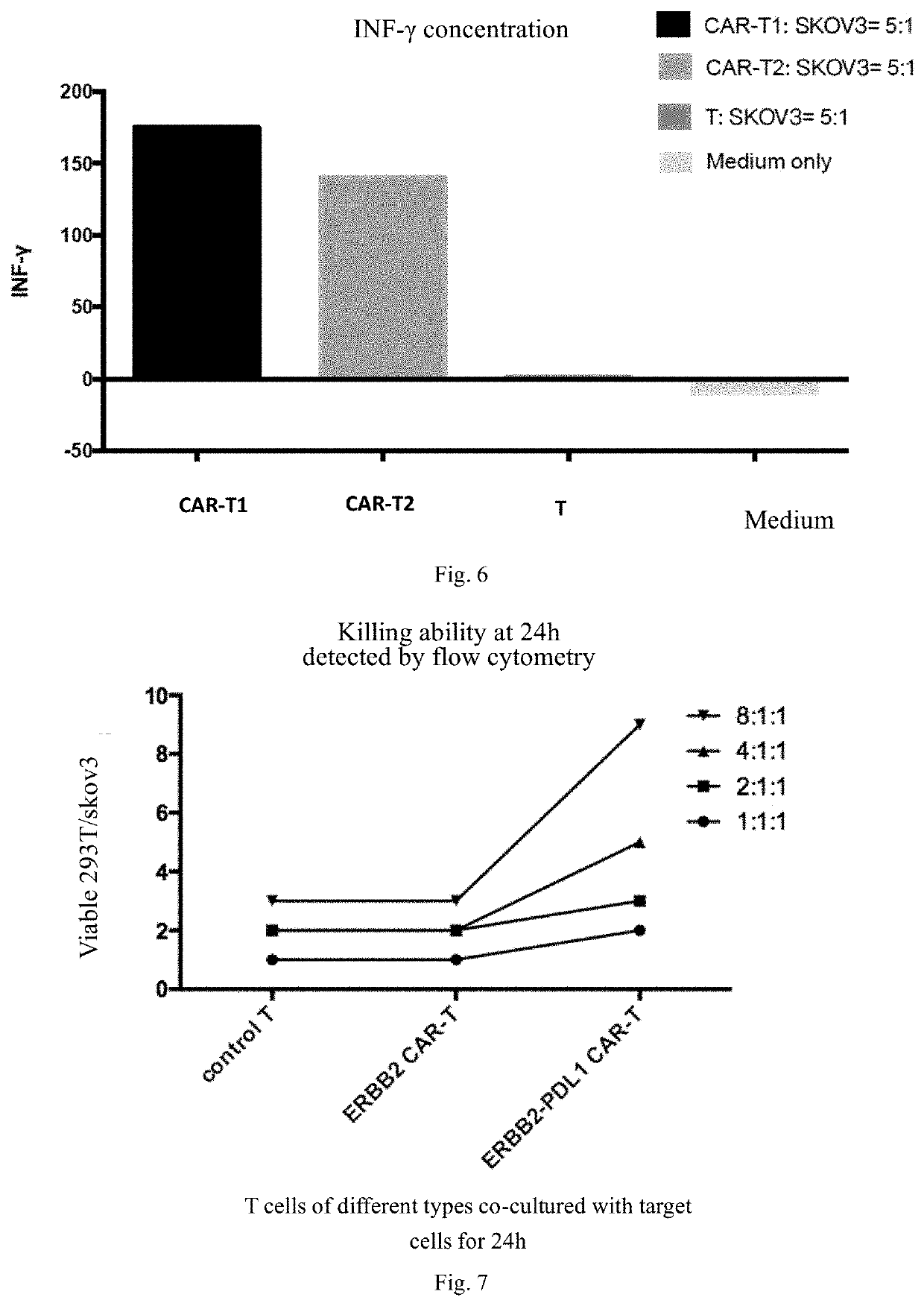Genetically engineered dual-targeting chimeric antigen receptor and use thereof
a technology of chimeric antigen receptor and dual-targeting, applied in the field of genetic engineering, can solve the problems of many difficulties in using car-ts for systemic car-t therapy, slow clinical application progress, etc., and achieve the effect of specific targeting
- Summary
- Abstract
- Description
- Claims
- Application Information
AI Technical Summary
Benefits of technology
Problems solved by technology
Method used
Image
Examples
example 1
Construction of Recombinant Lentiviral Vector for Dual-Targeting Chimeric Antigen Receptor
[0059]A recombinant vector for a dual-targeting chimeric antigen receptor was constructed with the following expression framework: HER2 scFv antibody-CD28 transmembrane domain-CD3ζ-Furin-P2A-PD-L1 scFv antibody-CD8 transmembrane domain-4-1BB from 5′ to 3′.
[0060]An amino acid sequence of a signal peptide of HER2 is shown in SEQ ID NO: 11, and a nucleotide sequence of the signal peptide of HER2 is shown in SEQ ID NO: 12.
[0061]An amino acid sequence of HER2scFv antibody is shown in SEQ ID NO: 13:
MQVQLQQSGPELKKPGETVKISCKASGYPFTNYGMNWVKQAPGQGLKWMGWINTSTGESTFADDFKGRFDFSLETSANTAYLQINNLKSEDSATYFCARWEVYHGYVPYWGQGTTVTVSSGGGGSGGGGSGGGGSDIQLTQSHKFLSTSVGDRVSITCKASQDVYNAVAWYQQKPGQSPKLLIYSASSRYTGVPSRFTGSGSGPDFTFTISSVQAEDLAVYFCQQHFRTPFTFGSGTKLEIK.
[0062]A coding nucleotide sequence of HER2 scFv antibody is shown in SEQ ID NO: 14:
ATGCAGGTACAACTGCAGCAGTCAGGACCTGAACTGAAGAAGCCTGGAGAGACAGTCAAGATCTCCTGCAAGGCCTCTGGGTA...
example 2
Transformation of Cells with Recombinant Vector
[0077]1. Culture and Passage of 293T Cells:
[0078]A biosafety cabinet was opened, then the countertop was wiped with 75% alcohol cotton, and pipettes, pipette tip boxes, 15m1 centrifuge tubes, a centrifuge tube rack and 10 cm2 new cell culture dishes were put in the biosafety cabinet. After the cabinet door was closed, a UV switch of the biosafety cabinet was turned on to irradiate for half an hour for disinfection and sterilization. DMEM containing 10% fetal bovine serum and 100 U / ml penicillin streptomycin and pancreatin were preheated in a 37° C. water bath. The biosafety cabinet was opened, a ventilation switch was turned on, and the culture dish for 293T cells grown to 80%-90% was taken out of a 37° C. incubator with 5% CO2 and put into the biosafety cabinet. The hands, mouth of a medium bottle and a pipette cylinder were disinfected with 75% alcohol. Medium in the culture dish was pipetted completely with a sterile pipette and disc...
example 3
Determination of Performance of Dual-Target CAR-Ts of HER2 and PDL1
[0094]1. Determination of In Vitro Killing Ability of CAR-Ts
[0095]Effector cells and target cells were stained with a Cell Trace™ CFSE Cell Proliferation Kit (Thermo) and a Cell Trace™ Far Red Cell Proliferation Kit (Thermo) respectively. The effector cells (e.g., T cells and CAR-Ts) and the target cells (e.g., SKOV3 and 293T cells) were added to a 12-well plate at a ratio of effector cells: target cells (E:T) of 1:1, 2:1, 4:1 and 8:1, with 1*106 target cells in each well, and control wells with only effector cells or target cells were added. Among them, SKOV3 was target cells and 293T cell was control negative cells. Results of flow cytometry were observed, and the death or proliferation of the target cells reflected the in vitro killing ability of CAR-Ts (see FIG. 7). The results in FIG. 7 show that the in vitro killing ability of dual-targeting CAR-Ts of HER2 and PDL1 to tumor cells is obviously better than that o...
PUM
| Property | Measurement | Unit |
|---|---|---|
| median survival time | aaaaa | aaaaa |
| temperature | aaaaa | aaaaa |
| concentration | aaaaa | aaaaa |
Abstract
Description
Claims
Application Information
 Login to View More
Login to View More - R&D
- Intellectual Property
- Life Sciences
- Materials
- Tech Scout
- Unparalleled Data Quality
- Higher Quality Content
- 60% Fewer Hallucinations
Browse by: Latest US Patents, China's latest patents, Technical Efficacy Thesaurus, Application Domain, Technology Topic, Popular Technical Reports.
© 2025 PatSnap. All rights reserved.Legal|Privacy policy|Modern Slavery Act Transparency Statement|Sitemap|About US| Contact US: help@patsnap.com



